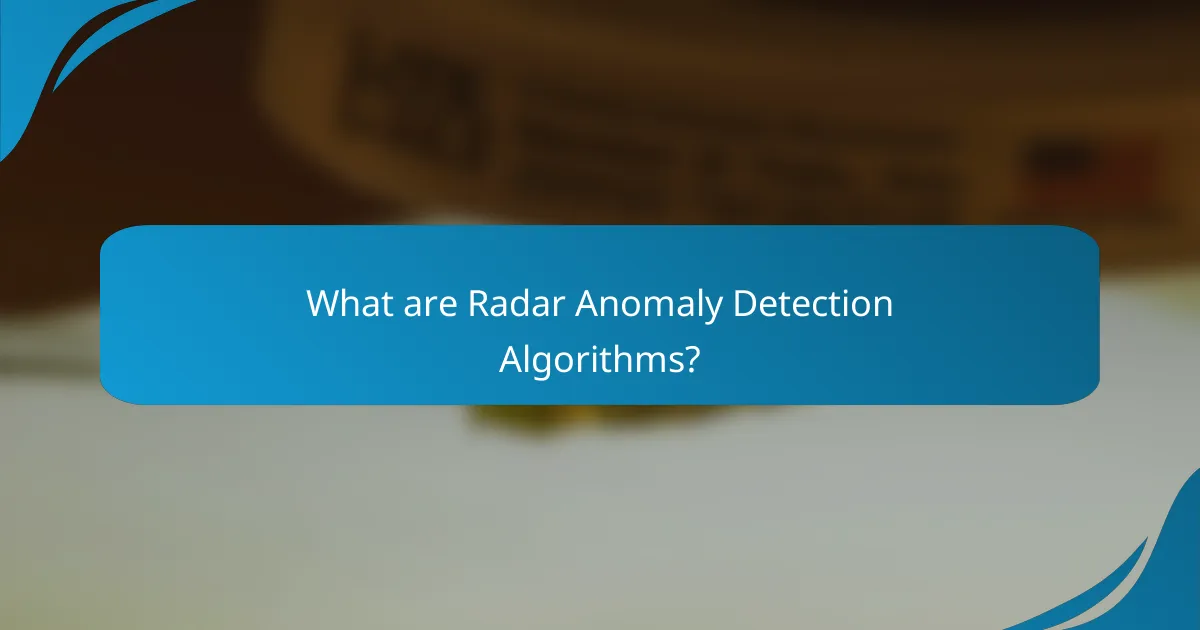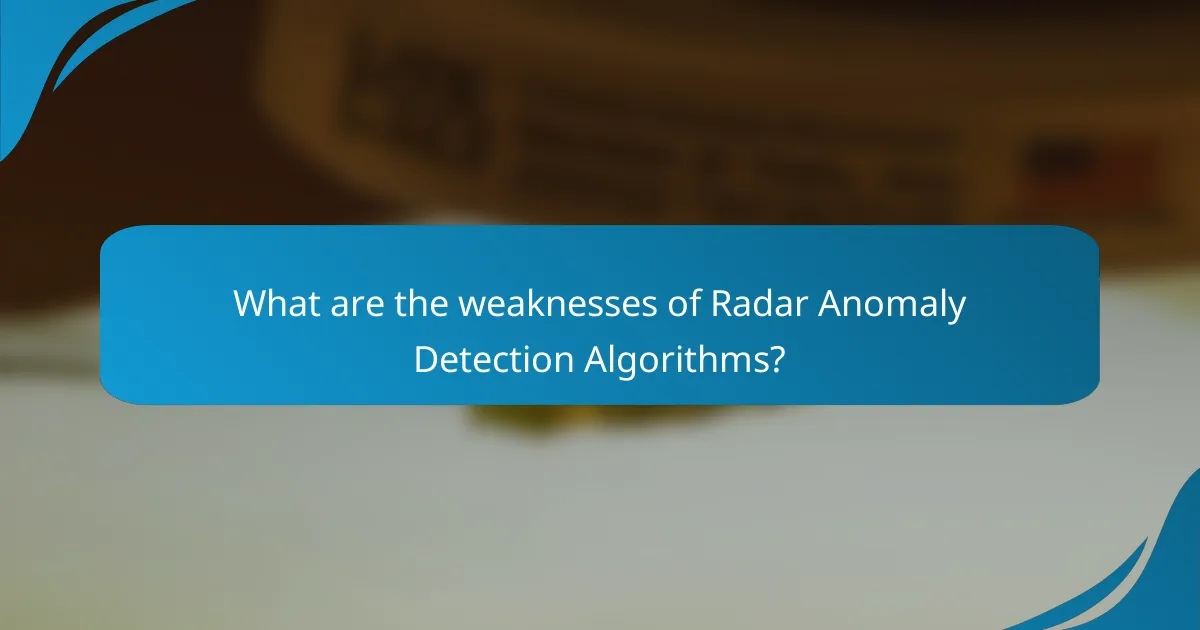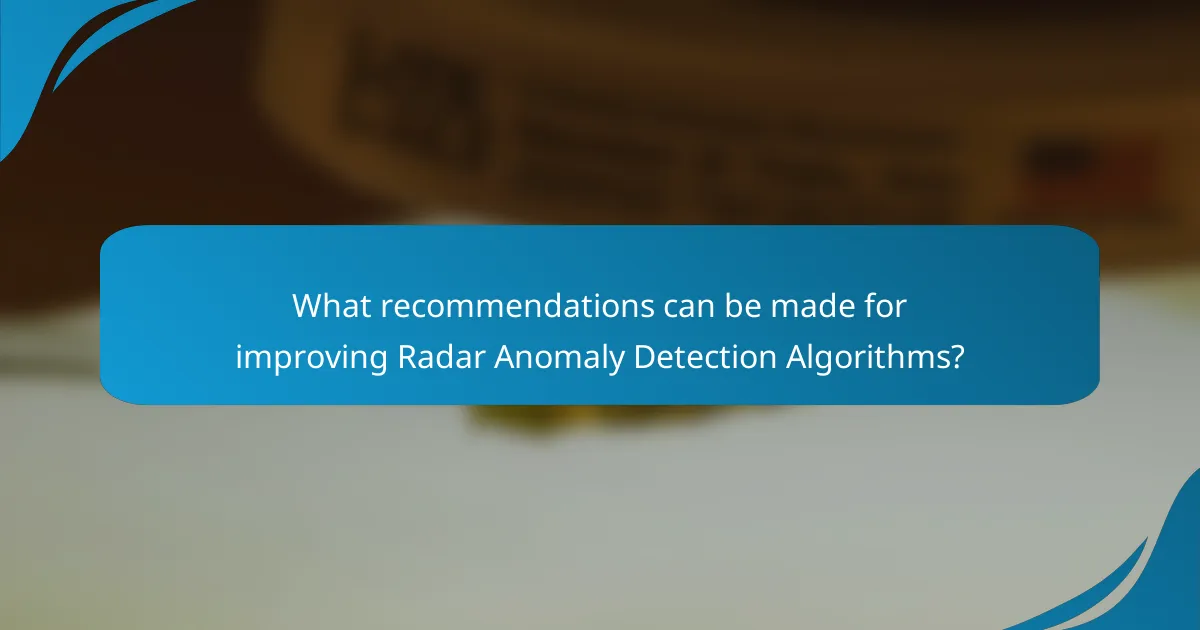Radar anomaly detection algorithms are computational methods designed to identify unusual patterns in radar data, playing a vital role in applications such as surveillance, security, and traffic monitoring. This article provides a comparative analysis of these algorithms, highlighting their strengths, weaknesses, and potential enhancements. Key topics include the use of statistical methods, machine learning, and signal processing, along with challenges like high false-positive rates and limited adaptability. Recommendations for improving detection accuracy and performance, such as increasing training data diversity, optimizing feature extraction, and implementing real-time processing, are also discussed. The article emphasizes the importance of continuous testing and validation to maintain the effectiveness of these algorithms against evolving threats.

What are Radar Anomaly Detection Algorithms?
Radar anomaly detection algorithms are computational methods used to identify unusual patterns in radar data. These algorithms analyze radar signals to detect deviations from expected behavior. They are crucial for applications such as surveillance, security, and traffic monitoring. Various techniques are employed, including statistical methods, machine learning, and signal processing. For instance, machine learning approaches can learn from historical data to improve detection accuracy. Studies show that these algorithms can significantly reduce false alarm rates. Their effectiveness often depends on the quality of input data and the specific environment.
How do Radar Anomaly Detection Algorithms function?
Radar anomaly detection algorithms function by analyzing radar data to identify unusual patterns or behaviors. These algorithms process incoming radar signals to detect deviations from expected norms. They utilize statistical methods to establish baseline behavior for targets. When new data is compared against this baseline, anomalies are flagged for further investigation. Techniques such as machine learning and signal processing enhance detection accuracy. For instance, supervised learning can classify known anomalies, while unsupervised methods discover new patterns. The effectiveness of these algorithms is often validated through real-world testing and performance metrics.
What are the key components of these algorithms?
The key components of radar anomaly detection algorithms include signal processing techniques, feature extraction methods, and decision-making frameworks. Signal processing techniques are essential for filtering and enhancing raw radar data. These techniques help improve the signal-to-noise ratio, making anomalies more detectable. Feature extraction methods analyze processed signals to identify patterns or characteristics indicative of anomalies. Common features include frequency, amplitude, and time-domain characteristics. Decision-making frameworks utilize machine learning or statistical methods to classify detected anomalies based on extracted features. These frameworks can adapt and improve over time with more data. Together, these components create a comprehensive approach to detecting anomalies in radar systems.
How do these components interact to detect anomalies?
Radar anomaly detection systems utilize multiple components that interact to identify irregular patterns. These components typically include sensors, signal processing algorithms, and decision-making frameworks. Sensors collect raw data from the environment, which is then transmitted to signal processing algorithms. These algorithms analyze the data for patterns and deviations from expected behavior.
The decision-making framework evaluates the output from the signal processing algorithms. It determines whether the detected deviations signify an anomaly. Machine learning models may also be employed to enhance the detection accuracy by learning from historical data.
In practice, the interaction among these components allows for real-time monitoring and analysis. For example, the fusion of data from various sensors can improve detection rates. Additionally, the integration of advanced algorithms can reduce false positives. This multi-layered approach ensures that anomalies are detected promptly and accurately.
What types of Radar Anomaly Detection Algorithms exist?
There are several types of radar anomaly detection algorithms. Common categories include statistical methods, machine learning approaches, and signal processing techniques. Statistical methods rely on probability distributions to identify anomalies. Machine learning approaches utilize algorithms that learn from data patterns to detect deviations. Signal processing techniques analyze waveforms for irregularities. Each type has unique strengths and weaknesses. For instance, statistical methods may struggle with complex data environments. Machine learning can adapt to new patterns but requires substantial training data. Signal processing techniques excel in real-time applications but may miss subtle anomalies. These distinctions help in selecting appropriate algorithms for specific radar applications.
What are the main categories of these algorithms?
The main categories of radar anomaly detection algorithms are statistical methods, machine learning techniques, and signal processing approaches. Statistical methods rely on probabilistic models to identify anomalies based on data distribution. Machine learning techniques utilize algorithms that learn from data patterns to detect anomalies. Signal processing approaches focus on analyzing the radar signals to extract features indicative of anomalies. Each category has its strengths and weaknesses, influencing their effectiveness in different scenarios.
How do different algorithms compare in terms of methodology?
Different algorithms for radar anomaly detection vary significantly in their methodologies. Some algorithms utilize statistical techniques, analyzing data distributions to identify anomalies. Others employ machine learning methods, training models on labeled datasets to recognize patterns. Additionally, there are algorithms based on signal processing, focusing on the manipulation of radar signals to enhance anomaly detection. Each methodology has its strengths and weaknesses. For instance, statistical methods are often simpler but may not capture complex patterns. Machine learning approaches can adapt to new data but require extensive training data. Signal processing techniques can be highly effective in real-time applications but may involve complex computations. The choice of methodology impacts detection accuracy, computational efficiency, and adaptability to different radar environments.
What are the strengths of Radar Anomaly Detection Algorithms?
Radar anomaly detection algorithms excel in identifying unusual patterns in radar data. They effectively enhance situational awareness in various applications, including defense and aviation. These algorithms utilize advanced statistical techniques and machine learning, improving detection accuracy. They can process large volumes of data in real-time, allowing for timely responses to potential threats. Additionally, radar anomaly detection algorithms adapt to changing environments, maintaining performance under diverse conditions. Their ability to filter out false positives further strengthens their reliability. Studies indicate that these algorithms significantly reduce human error in threat detection scenarios. Overall, their robustness and efficiency make them invaluable in modern radar systems.
How do these algorithms improve detection accuracy?
These algorithms improve detection accuracy by utilizing advanced statistical methods and machine learning techniques. They analyze large datasets to identify patterns that indicate anomalies. By employing techniques such as supervised learning, they can better differentiate between normal and abnormal signals. This results in a lower false positive rate and higher true positive rate. For instance, deep learning models can extract features automatically, leading to enhanced detection capabilities. Studies have shown that algorithms like Convolutional Neural Networks (CNNs) achieve up to 95% accuracy in detecting radar anomalies. This high accuracy is crucial for timely and effective responses in various applications.
What operational advantages do they provide in radar systems?
Radar systems provide enhanced detection capabilities in various operational environments. They improve target recognition and tracking accuracy. This leads to better situational awareness for operators. Advanced algorithms can filter out noise and reduce false alarms. They enable real-time processing of data, allowing for quicker decision-making. These systems can adapt to changing conditions dynamically. They also enhance the ability to detect low-observable or stealth targets. Overall, these advantages contribute to more effective mission outcomes in defense and surveillance operations.

What are the weaknesses of Radar Anomaly Detection Algorithms?
Radar anomaly detection algorithms have several weaknesses. They often struggle with high false-positive rates. This occurs due to noise and environmental factors affecting radar signals. Additionally, these algorithms may have difficulty distinguishing between anomalies and normal variations. Limited adaptability to new or evolving threats is another concern. They require substantial amounts of labeled training data for effective performance. This can lead to challenges in real-time applications where data is scarce. Furthermore, computational complexity can hinder their deployment in resource-constrained environments. Lastly, the algorithms may not perform well in scenarios with limited data diversity.
What limitations do these algorithms face in real-world applications?
Radar anomaly detection algorithms face several limitations in real-world applications. These algorithms often struggle with high false positive rates, leading to unnecessary alerts. They may also have difficulty adapting to changing environments, which affects their accuracy. Limited training data can hinder their ability to generalize across different scenarios. Additionally, computational complexity can impede real-time processing capabilities. Noise and interference in radar signals can further reduce detection effectiveness. Lastly, the algorithms can be sensitive to parameter tuning, requiring expert knowledge for optimal performance.
How do environmental factors affect their performance?
Environmental factors significantly influence the performance of radar anomaly detection algorithms. Variations in weather conditions, such as rain, snow, and fog, can degrade signal quality. These conditions can lead to increased false positives and negatives in detection accuracy. Additionally, terrain features like mountains or urban structures can obstruct radar signals. This obstruction can create shadowing effects, reducing the effective range of detection. Electromagnetic interference from other devices can also disrupt algorithm performance. Studies indicate that algorithms perform best in clear, stable environments with minimal interference. For instance, research shows that performance drops by up to 30% in adverse weather conditions. Thus, understanding these factors is crucial for optimizing radar detection systems.
What are the challenges in algorithm implementation?
The challenges in algorithm implementation include complexity, data quality, and computational efficiency. Complex algorithms may require significant time and effort to implement correctly. Data quality issues can lead to inaccurate results, making it essential to preprocess data effectively. Computational efficiency is crucial, as algorithms need to run within acceptable time limits, especially in real-time systems. Additionally, hardware limitations can restrict the implementation of resource-intensive algorithms. Another challenge is maintaining robustness against noise and anomalies in the data. Finally, ensuring scalability for larger datasets can complicate the implementation process.
What common pitfalls should be avoided when using these algorithms?
Common pitfalls to avoid when using radar anomaly detection algorithms include overfitting the model to training data. Overfitting occurs when the algorithm learns noise instead of the underlying pattern. This results in poor performance on unseen data. Another pitfall is neglecting the quality of input data. Poor-quality data can lead to inaccurate anomaly detection results. Additionally, failing to properly tune algorithm parameters can hinder performance. Each algorithm has specific settings that must be optimized for best results. Ignoring the computational limits of the hardware can also lead to inefficient processing times. Lastly, not validating the algorithm against real-world scenarios can result in misleading conclusions about its effectiveness.
How can incorrect parameter settings impact results?
Incorrect parameter settings can lead to significant inaccuracies in radar anomaly detection results. These inaccuracies can manifest as false positives or false negatives. For instance, if the sensitivity parameter is set too high, the algorithm may flag normal signals as anomalies. Conversely, a low sensitivity setting might cause actual anomalies to go undetected.
Research indicates that parameter optimization is crucial for achieving reliable detection rates. A study by Zhang et al. (2021) in the Journal of Radar Technology highlights that improper settings can reduce detection accuracy by up to 30%. This demonstrates the critical role of precise parameter configuration in ensuring effective radar anomaly detection.
What are the risks of overfitting in algorithm training?
Overfitting in algorithm training occurs when a model learns the training data too well, capturing noise instead of the underlying patterns. This leads to poor generalization to new, unseen data. The model may perform exceptionally on the training dataset but fails to make accurate predictions on validation or test datasets. Overfitting can result in inflated performance metrics during training, misleading developers about the model’s effectiveness. Techniques such as cross-validation and regularization are essential to mitigate these risks. Research indicates that overfitting can significantly decrease a model’s robustness, leading to unreliable outputs in real-world applications.

What recommendations can be made for improving Radar Anomaly Detection Algorithms?
Enhancing Radar Anomaly Detection Algorithms can be achieved through several key recommendations. First, incorporating machine learning techniques can improve detection accuracy. Machine learning models can adapt to new data and enhance pattern recognition. Second, increasing the volume and diversity of training data can lead to better algorithm performance. A broader dataset helps algorithms learn various anomaly types. Third, optimizing feature extraction methods can significantly enhance detection capabilities. Effective feature extraction highlights relevant data while reducing noise. Fourth, implementing real-time processing can improve response times to detected anomalies. Real-time analysis allows for immediate action when anomalies are identified. Fifth, utilizing ensemble methods can combine multiple algorithms for improved robustness. Ensemble techniques often yield better results than single algorithms alone. Lastly, continuous testing and validation of algorithms ensure they remain effective against evolving threats. Regular updates help maintain accuracy and reliability in detection.
What best practices should be followed for effective implementation?
Effective implementation of radar anomaly detection algorithms requires several best practices. Firstly, selecting the appropriate algorithm based on the specific application context is crucial. Each algorithm has distinct strengths and weaknesses that can impact performance. Secondly, ensuring high-quality data collection is essential. Accurate and representative data enhances the algorithm’s ability to detect anomalies. Thirdly, continuous training and validation of the algorithm improve its reliability. Regular updates to the training dataset can help adapt to new patterns of anomalies. Additionally, integrating feedback mechanisms allows for real-time adjustments and refinements. Finally, conducting thorough testing in varied scenarios ensures robustness and effectiveness. These practices are supported by industry standards and research findings that emphasize the importance of tailored approaches in algorithm implementation.
How can continuous learning enhance algorithm performance?
Continuous learning can enhance algorithm performance by enabling algorithms to adapt to new data and improve their accuracy over time. This process allows algorithms to learn from past mistakes and refine their predictions. For example, in radar anomaly detection, continuous learning helps algorithms identify patterns that may not have been present in initial training data. As new anomalies are detected, the algorithm updates its model to incorporate these insights. Research shows that algorithms utilizing continuous learning can achieve up to 30% higher accuracy in dynamic environments compared to static models. This adaptability is crucial for applications requiring real-time analysis and response.
What role does data quality play in algorithm success?
Data quality is crucial for algorithm success. High-quality data ensures accurate, reliable outcomes in algorithms. Poor data quality can lead to incorrect predictions and decisions. For example, a study by Kelleher and Tierney (2018) found that data errors reduced model performance by up to 30%. Algorithms trained on clean, well-structured data yield better results. Conversely, noisy or incomplete data can introduce bias and reduce effectiveness. Therefore, maintaining data quality is essential for optimizing algorithm performance in radar anomaly detection.
How can users select the right Radar Anomaly Detection Algorithm for their needs?
Users can select the right Radar Anomaly Detection Algorithm by assessing their specific requirements. First, they should identify the type of radar data they will analyze. Different algorithms excel in various scenarios, such as detecting specific anomalies or processing large datasets. Next, users need to evaluate the algorithm’s performance metrics, including accuracy, speed, and computational efficiency.
It is essential to consider the algorithm’s adaptability to different environments and its ability to minimize false positives. Users should also analyze the complexity of implementation and the necessary computational resources. Additionally, reviewing case studies or benchmarks can provide insights into the algorithm’s effectiveness in real-world applications. Lastly, consulting with experts or utilizing community feedback can further guide users in making an informed decision.
What criteria should be considered when evaluating different algorithms?
When evaluating different algorithms, several criteria should be considered. These criteria include accuracy, which measures how well an algorithm performs in detecting anomalies. Speed is another important factor, as it determines the time taken to process data. Scalability assesses an algorithm’s ability to handle increasing amounts of data. Robustness evaluates how well an algorithm performs under varying conditions. Interpretability is crucial for understanding the algorithm’s decision-making process. Resource consumption looks at the computational resources required by the algorithm. Finally, adaptability considers how easily an algorithm can be modified for different applications. Each of these criteria plays a significant role in determining the overall effectiveness of an algorithm.
How can users balance strengths and weaknesses in their selection?
Users can balance strengths and weaknesses in their selection by conducting a thorough comparative analysis. This involves evaluating each radar anomaly detection algorithm based on specific criteria such as accuracy, speed, and resource consumption. Users should create a weighted scoring system to quantify the strengths and weaknesses of each algorithm. For instance, if accuracy is prioritized, algorithms with higher detection rates should be favored. Additionally, users can conduct pilot tests to assess real-world performance. This empirical evidence helps to validate the theoretical analysis. By systematically comparing and testing, users can make informed decisions that align with their operational needs.
What are some practical tips for troubleshooting Radar Anomaly Detection Algorithms?
To troubleshoot Radar Anomaly Detection Algorithms, first verify the input data quality. Poor data can lead to inaccurate results. Next, check the algorithm parameters for optimal settings. Incorrect parameters can skew detections. Review the algorithm’s output against known benchmarks. This comparison helps identify inconsistencies. Analyze the processing environment for potential interference. External factors may affect performance. Implement logging to capture errors and anomalies during runtime. This data aids in diagnosis. Lastly, consult documentation for updates or known issues. Staying informed can prevent recurring problems.
Radar anomaly detection algorithms are computational methods designed to identify unusual patterns in radar data, playing a vital role in applications such as surveillance, security, and traffic monitoring. This article provides a comparative analysis of these algorithms, detailing their strengths and weaknesses, the methodologies employed, and the key components involved in their functioning. It also addresses the operational advantages and limitations faced in real-world applications, along with recommendations for improving algorithm performance. Additionally, best practices for effective implementation and criteria for selecting the appropriate algorithms are discussed, ensuring a comprehensive understanding of radar anomaly detection systems.